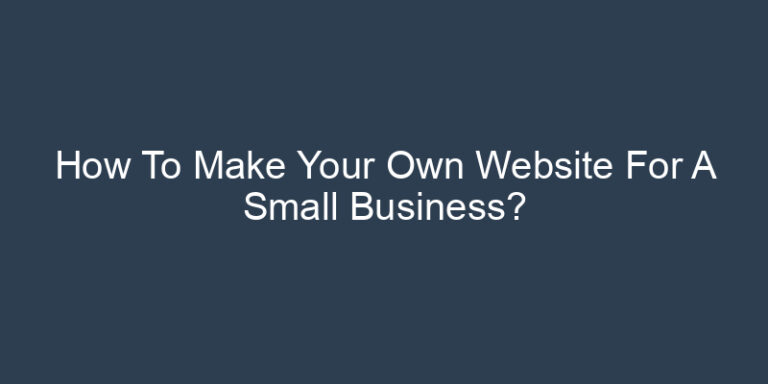Running a small business without a website? You’re missing out on opportunities to connect with customers and grow your brand. Having your own website is essential nowadays. And guess what? You don’t need to spend a fortune hiring a web designer or developer. You can do it yourself! Here’s a simple guide to help you build a website that works for your business.
Step 1: Plan Your Website
Before diving in, you need a plan. Think about what you want to achieve with your website. Are you looking to sell products, gather leads, or simply showcase your services? Having a clear goal will make everything easier later on.
Also, know your audience. Is it local customers? A specific industry? Tailor your design and content to match who you’re trying to reach.
Lastly, you’ll need to decide which platform to use. There are plenty of website builders like WordPress, Wix, and Squarespace. Each has its pros and cons. WordPress offers more customization, but Wix and Squarespace are super beginner-friendly. Pick the one that fits your comfort level.
Step 2: Register a Domain Name
The next step is to get yourself a domain name. This is your website’s address on the internet. Keep it simple and professional. Your business name is a good start, or something closely related. Avoid weird spellings and numbers, which could confuse potential customers.
Use registrars like GoDaddy or Namecheap to buy your domain. They offer great tools to help you pick the best one that’s still available. It’s an easy process and usually costs around $10-20 a year.
Step 3: Find a Web Hosting Provider
Once you’ve got your domain, you need somewhere to store your website. This is where web hosting comes in. There are three main types: shared hosting (cheap and basic), VPS (a bit more power), and dedicated hosting (the best but expensive). For small businesses, shared hosting is usually enough.
When picking a host, look for reliability, speed, and customer support. You don’t want your site crashing during a sale or when you’re getting a surge of traffic. Popular hosts include Bluehost, SiteGround, and HostGator.
Step 4: Design Your Website
Now for the fun part—designing your site. You can use pre-built templates, which make things super easy, or you can go for a custom design if you want something unique. Either way, make sure it’s simple, clean, and easy to navigate.
Also, make sure it works on phones and tablets. A lot of people will be visiting your site from their mobile devices, and if it’s not mobile-friendly, they’ll just leave.
Don’t forget the basics. Every business website needs:
- Home Page: A clear, welcoming introduction to your business.
- About Page: Share your story, your team, and why you’re the best.
- Services/Products Page: Highlight what you offer.
- Contact Page: Let people know how to reach you.
- Testimonials: Show off some happy customers.
Also, make sure your design reflects your brand. Stick to a color scheme, fonts, and logo that align with your business.
Step 5: Add Content to Your Website
Good design gets attention, but great content keeps it. Start with solid copywriting. Be clear and to the point. No one has time to read long, boring blocks of text.
Focus on the benefits your business offers. Why should someone choose you over a competitor? Make it easy for visitors to find what they’re looking for. And always include strong calls to action like “Contact Us,” “Buy Now,” or “Get a Quote.”
Use images and videos where possible. Visuals make a big difference and help break up text. Just be sure they’re high quality—blurry or pixelated photos won’t do you any favors.
If you’re thinking about SEO (and you should be), include your main keywords in the headlines and throughout the text naturally. But don’t go overboard with keyword stuffing—that just looks bad.
Step 6: Set Up Essential Features
Don’t forget the practical stuff. You’ll need a contact form so potential customers can reach out. It’s an easy way to generate leads without having to share your email address online.
If you’re planning to sell products, you’ll need to set up an e-commerce platform. Most website builders have this feature built-in. You can accept payments through PayPal, Stripe, or other processors.
Lastly, install Google Analytics or another tracking tool. This will help you see how many people visit your site, which pages are popular, and how they found you. It’s vital information for growing your online presence.
Step 7: Test and Launch Your Website
Before going live, you need to test everything. Make sure your site works well on different browsers like Chrome, Firefox, and Safari. Also, check it on mobile devices to ensure it’s responsive and looks good.
Speed is another factor. No one likes a slow website. Use tools like Google PageSpeed Insights to check your loading times and optimize if necessary.
When everything looks good, it’s time to launch. Congratulations, your site is live! Now, you can start promoting it.
Step 8: Maintain Your Website
Once your site is live, the work isn’t over. You need to keep it updated with fresh content, blog posts, or new products. Plus, don’t forget to back it up regularly—just in case something goes wrong.
Security is another concern. Install updates to your website’s software, especially if you’re using WordPress. You don’t want hackers taking over your site, which can damage your brand reputation.
Conclusion
Building your own small business website might seem like a challenge, but with the right tools and a little patience, it’s completely doable. Once your site is up and running, it’ll become a powerful tool for reaching customers, driving sales, and growing your business.
If you’re looking for a more streamlined solution or don’t want to handle it all yourself, check out SB Website for options to buy, rent, or even build your own small business website. They offer flexible solutions to get your business online quickly.

